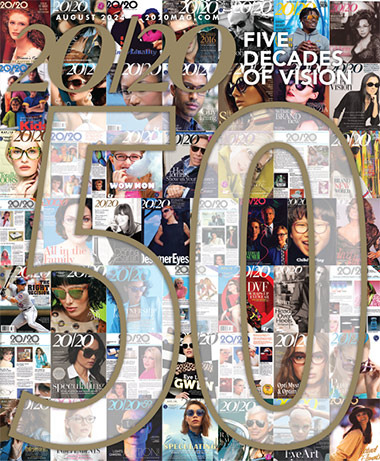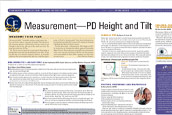
By Jillian Urcelay
Long before the days of social media, influencers, display ads and email newsletters, most companies solely relied on print advertising to market their brand to consumers. These ads both reflected the culture of the time and helped shape it. As I scoured through hundreds (maybe thousands?) of archived 20/20 pages from the past 50 years, I spent a lot of time admiring vintage eyewear ads. While many of them have made me laugh—some would definitely not be appropriate today—the majority paint a perfect picture of the progression and transformation of the eyewear industry as a whole.
Browsing through ads from the mid to late 1970s when our magazine was born, it’s clear that big and bold designs were in. Women are seen wearing oversized plastic frames in interesting colors, shapes and angles, while men are often sporting pilot shaped metal options. During this time, ad pages were utilized to truly tell a story, and most often featured a large headline and body copy underneath to spread a company’s message. As we move into the 1980s, we see the layouts simplify. The pages begin to lose a majority of the text and focus on one main image, which was most often a woman. Eyewear styles began to shift toward a softer look with mixed materials and unique designs including drop and curved temples. As metal styles for women grew in popularity, we also see a rise in the straight across brow bar, as well as added detailing. The biggest change in advertising and the industry as a whole occurred during these years. We see the rise of designer licensing agreements and a transition from companies promoting themselves to focusing instead on their new brands.
As we move into the 1990s, there was a major shift toward stylistic simplicity in both eyewear and its ads. Most advertisements begin to feature one large image with the brand name below it, which continues to be popular today. In terms of eyewear, thin silver and gold metal styles were thriving, and designs were sleek with narrow and small round shapes trending. We also see companies begin to opt toward black and white ad pages to make a statement. This minimalistic approach carries through to the early 2000s, and brands begin to use digital imagery to enhance advertisements. Narrow styles continue their reign in popularity, but shapes lean toward tiny rectangles and ovals. Minimalism continues in the sunwear space as colorful rimless designs soar.
Dennis Murphy, 20/20’s Vice President of Sales, was first hired by Jobson Optical Group in 1982 as a sales manager. Over the past 40 years, Murphy has sold over 20,000 ad pages including some of the selections highlighted in this feature. When asked about 20/20’s role in the optical industry’s history, Murphy says, “In 1982, there were sparse size and color offerings, and even fewer brand or designer brand collections. Glass bifocal lenses were common, and television personalities wearing eyewear often had a glare reflecting into the camera. It took a week or more to get your Rx filled, and contact lens companies promoted, ‘Men don’t make passes at girls who wear glasses.’ I believe 20/20 magazine is the major reason none of that is true today.”
While we agree 20/20 has made a lasting impact on the industry, it’s clear that eyewear advertising also changed the culture. To that same sentiment, our editorial staff happily acknowledges that the advertisements that fill our publication play a vital part in bringing this magazine to life. The creativity that appears in today’s ads consistently inspires our team and energizes our passion for eyewear. We are grateful to our sponsors of the past and present who continue to support our vision of this industry and allow us to share it with you each month.
Over the past 10 years, we’ve witnessed digital advertising completely change the print publishing world. Live events and email newsletters have become essential to communicating with our readers. We see the value in the digital space, especially for our partners, with the opportunity for almost unlimited advertising and direct measurables on an ad’s performance. Still today, according to Murphy, when asked, many opticians, optometrists and eyecare professionals say they prefer print to digital in terms of learning about new products and educational information. We are happy to oblige and will continue to share our dedicated partners’ voices as we forge onward in this new era of advertising. ■


















